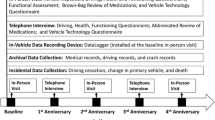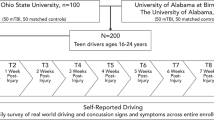Abstract
Veterans are at an increased risk of being injured or killed in motor vehicle crashes, potentially due to their proclivity to engage in risky driving behaviors. However, most research in this area has focused on driving behaviors of veterans who have recently returned home after deployment. No research has focused on risky driving behaviors of older veterans (aged 65 or older) and if risky driving behaviors extend beyond the time period immediately following return from deployment. The purpose of this research is to determine if differences exist in risky driving behaviors of veterans and non-veterans aged 65 or older. This study used data from the 2011 National Health and Aging Trend Study (NHATS), a nationally representative, longitudinal survey of community-dwelling, Medicare beneficiaries aged 65 or older. Binary logistic regression analyses were conducted in 2017 to determine if veteran’s status was predictive of specific risky driving behaviors. Veteran’s status was found to be predictive of specific driving behaviors for adults aged 65 and older, with non-veterans significantly more likely than veterans to: not currently drive; avoid driving at night; avoid driving alone; avoid driving on busy roads or highways; and avoid driving in bad weather. The results of this study highlight the need to further understand the effects of veteran’s status on risky driving behaviors among older adults, specifically, whether veteran’s status compounds driving-related risks associated with aging-related physical and mental changes.
Similar content being viewed by others
References
Sheppard, S. C., & Earleywine, M. (2013). Using the unmatched count technique to improve base rate estimates of risky driving behaviours among veterans of the wars in Iraq and Afghanistan. Injury Prevention, 19(6), 382–386.
Bullman, T. A., Kang, H. K., Smolenski, D. J., Skopp, N. A., Gahm, G. A., & Reger, M. A. (2017). Risk of motor vehicle accident death among 1.3 million veterans of the Iraq and Afghanistan wars. Traffic Injury Prevention, 18(4), 369–374.
Drescher, K. D., Rosen, C. S., Burling, T. A., & Foy, D. W. (2003). Causes of death among male veterans who received residential treatment for PTSD. Journal of Traumatic Stress, 16(6), 535–543.
Kang, H. K., & Bullman, T. A. (1996). Mortality among US veterans of the Persian Gulf War. New England Journal of Medicine, 335(20), 1498–1504.
Lincoln, A. E., Hooper, T. I., Kang, H. K., DeBakey, S. F., Cowan, D. N., & Gackstetter, G. D. (2006). Motor vehicle fatalities among Gulf War era veterans: Characteristics, mechanisms, and circumstances. Traffic Injury Prevention, 7(1), 31–37.
Plach, H. L., & Sells, C. H. (2013). Occupational performance needs of young veterans. American Journal of Occupational Therapy, 67(1), 73–81.
Lew, H. L., Amick, M. M., Kraft, M., Stein, M. B., & Cifu, D. X. (2010). Potential driving issues in combat returnees. NeuroRehabilitation, 26(3), 271–278.
Fear, N. T., Iversen, A. C., Chatterjee, A., Jones, M., Greenberg, N., Hull, L., … Wessely, S. (2008). Risky driving among regular armed forces personnel from the United Kingdom. American Journal of Preventive Medicine, 35(3), 230–236.
Knapik, J. J., Marin, R. E., Grier, T. L., & Jones, B. H. (2009). A systematic review of post-deployment injury-related mortality among military personnel deployed to conflict zones. BMC Public Health, 9(1), 231.
Possis, E., Bui, T., Gavian, M., Leskela, J., Linardatos, E., Loughlin, J., & Strom, T. (2014). Driving difficulties among military veterans: Clinical needs and current intervention status. Military Medicine, 179(6), 633–639.
Kuhn, E., Drescher, K., Ruzek, J., & Rosen, C. (2010). Aggressive and unsafe driving in male veterans receiving residential treatment for PTSD. Journal of Traumatic Stress, 23(3), 399–402.
Sayer, N. A., Noorbaloochi, S., Frazier, P., Carlson, K., Gravely, A., & Murdoch, M. (2010). Reintegration problems and treatment interests among Iraq and Afghanistan combat veterans receiving VA medical care. Psychiatric Services, 61(6), 589–597.
Strom, T. Q., Leskela, J., James, L. M., Thuras, P. D., Voller, E., Weigel, R., … Holz, K. B. (2012). An exploratory examination of risk-taking behavior and PTSD symptom severity in a veteran sample. Military Medicine, 177(4), 390–396.
Okie, S. (2005). Traumatic brain injury in the war zone. New England Journal of Medicine, 352(20), 2043–2047.
Bell, N. S., Amoroso, P. J., Wegman, D. H., & Senier, L. (2001). Proposed explanations for excess injury among veterans of the Persian Gulf War and a call for greater attention from policymakers and researchers. Injury Prevention, 7(1), 4–9.
Killgore, W. D. S., et al. (2008). “Post-combat invincibility: Violent combat experiences are associated with increased risk-taking propensity following deployment. Journal of Psychiatric Research, 42(13), 1112–1121.
Hoggatt, K. J., Prescott, M. R., Goldmann, E., Tamburrino, M., Calabrese, J. R., Liberzon, I., & Galea, S. (2015). The prevalence and correlates of risky driving behavior among National Guard soldiers. Traffic Injury Prevention, 16(1), 17–23.
Meyer, J. (2004). Personal vehicle transportation. In R. Pew & S. Van Hemel (Eds.), Technology for adaptive aging. Washington, DC: The National Academies Press.
Baldock, M. R. J., Mathias, J. L., McLean, A. J., & Berndt, A. (2006). Self-regulation of driving and its relationship to driving ability among older adults. Accident Analysis & Prevention, 38(5), 1038–1045.
Molnar, L. J., Eby, D. W., Charlton, J. L., Langford, J., Koppel, S., Marshall, S., & Man-Son-Hing, M. (2013). Reprint of “driving avoidance by older adults: Is it always self-regulation?” Accident Analysis & Prevention, 61, 272–280.
Molnar, L. J., Charlton, J. L., Eby, D. W., Langford, J., Koppel, S., Kolenic, G. E., & Marshall, S. (2014). Factors affecting self-regulatory driving practices among older adults. Traffic Injury Prevention, 15(3), 262–272.
National Health and Aging Trends Study (NHATS). (2011). Produced and distributed by www.nhats.org with funding from the National Institute on Aging (grant number NIA U01AG32947). Baltimore, MD: John Hopkins University.
Kasper, J. D., & Freedman, V. A. (2014). National health and aging trends study user guide: Rounds 1 & 2, final release. Baltimore: John Hopkins University School of Public Health.
Lum, H. D., Ginde, A. A., & Betz, M. E. (2015). Older adult drivers living in residential care facilities. The Annals of Long-Term Care, 23(7), 21.
Bauer, M. J., Adler, G., Kuskowski, M. A., & Rottunda, S. (2003). The influence of age and gender on the driving patterns of older adults. Journal of Women & Aging, 15(4), 3–16.
Pristavec, T. (2016). Social participation in later years: The role of driving mobility. Journals of Gerontology Series B. https://doi.org/10.1093/geronb/gbw057.
Tabachnick, B. G., & Fidell, L. S. (2013). Using multivariate statistics (6th ed.). Boston, MA: Pearson.
Guerin, B. (1994). What do people think about the risks of driving? Implications for traffic safety interventions. Journal of Applied Social Psychology, 24(11), 994–1021.
Barth, S. K., Kang, H. K., & Bullman, T. (2016). All-cause mortality among US Veterans of the Persian Gulf War: 13-year follow-up. Public Health Reports, 131(6), 822–830.
Schwarz, N. (2007). Retrospective and concurrent self-reports: The rationale for real-time data capture. The science of real-time data capture: Self-reports in health research, 11, 26.
Winter, S., Szafranski, E., Classen, S., Yarney, A., Monahan, M., Platek, K., … Levy, C. (2016). Combat Veterans’ strategies to manage risky driving and preferences for driving intervention. The American Journal of Occupational Therapy, 70(4_Supplement_1), 7011515253p1.
Acknowledgements
The National Health and Aging Trends Study (NHATS) is sponsored by the National Institute on Aging (Grant Number NIA U01AG032947) through a cooperative agreement with the Johns Hopkins Bloomberg School of Public Health. The National Institute on Aging had no role in the design and conduct of the current study; management, analysis, and interpretation of the data; and preparation, review, or approval of the manuscript.
Author information
Authors and Affiliations
Contributions
ALH-Z conceived of the study design, analyzed the data, assisted in drafting the manuscript, and approved of the final version of the manuscript draft to be published. KDH reviewed the data analysis, assisted in drafting the manuscript, and approved of the final version of the manuscript draft to be published.
Corresponding author
Ethics declarations
Conflict of interest
No conflict of interest were reported by the authors of this paper.
Rights and permissions
About this article
Cite this article
Huseth-Zosel, A.L., Hammer, K.D. Risky Driving Behaviors for Older Adults: Differences by Veteran’s Status. J Community Health 43, 827–832 (2018). https://doi.org/10.1007/s10900-018-0489-x
Published:
Issue Date:
DOI: https://doi.org/10.1007/s10900-018-0489-x




